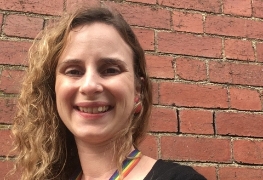
in the early stages KWS was his main communication tool
About Nicki
Nicki is a speech pathologist who has integrated Key Word Sign (KWS) into her clinical practice. She predominantly works in a community health setting and works with a wide range of clients from inner city Melbourne and country Victoria. Many of these come from different language backgrounds. She feels that KWS has significant value in promoting language development and facilitating communication in the children she sees. Nicki shares a personal story and presents a new perspective into opportunities of KWS as a cross-linguistic tool, as well as being a tool to support communication and language development.
Since attending a KWS (known as Makaton by then) workshop at university, Nicki has continued to develop her skill in using sign. She has found that KWS is a great steppingstone for children with delayed speech and language development and is now incorporating sign in her sessions with most of the children she works with. For children with delayed receptive language skills (understanding), KWS provides a visual cue to support children to pay attention to the person speaking and gives them more information to help them understand what was said. She has also found KWS helpful in supporting children to manage their behaviour, as they had more understanding of what was about to happen, and were better able to express themselves when their speech was not sufficient to get their message across. Nicki knows (and the research evidence supports this) that children learning KWS will develop speech if that is possible for them. For children with more significant communication difficulties, KWS may be a primary mode of communication.
Meet Thanh
Thanh (not his real name) is 4 years old, and lives besides a community health centre in inner city Melbourne with his family. He has 3 brothers, an older brother who has been diagnosed with autism and two younger brothers. The family speaks both English and Vietnamese at home. He also attends kindergarten where the teachers speak both English and Vietnamese with the children. Thanh has delays with his development, ie delays in his motor and communication skills and accesses funding through the NDIS.
Over the past two years, Nicki has introduced KWS to Thanh and his family. She also used aided language displays (boards with pictures for a range of topics or activities). Thanh’s Mum attended a one-day KWS training workshop and was more comfortable using this with him at home, so in the early stages KWS was his main communication tool. He is now able to use spoken sentences of 3-4 words, however his speech can be difficult to understand. KWS has been an important strategy in facilitating his communication, particularly when speaking English. KWS also played an important role for him of bridging between two contrasting languages.
There have been a few concerns. Thanh’s delay in motor skill development meant that he was not always able to produce signs accurately when first learning to use signs. Mostly people who knew could understand the signs he was trying to use, and Nicki developed a KWS dictionary for him so that other people could refer to it to work out the signs he was using. The other challenge was to get everyone in Thanh’s world to use signs with him. Thanh’s mother and to a lesser extent his older brother used KWS at home. Implementing KWS in Thanh’s kindergarten was important, but not easy to get going.
Currently, Thanh is developing stronger use of verbal language and uses KWS less, but he will revert to it at times to repair communication breakdowns (ie when his speech is not understood). Nicki models KWS throughout her sessions with Thanh, to help him learn new vocabulary and develop further complexity in his use of spoken language.
Nicki plans to continue to use multi-modal communication strategies to support Thanh’s language development. This could include ongoing development of low-tech communication aids which could be used at home, kindergarten and possibly school as he progresses. Nicki suggests that the family should trial high-tech communication options, as another method of communication going forward. Most importantly, Nicki recommends that it is important to continue to model signs to develop language.

